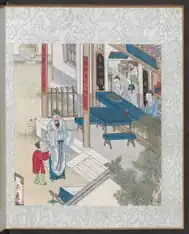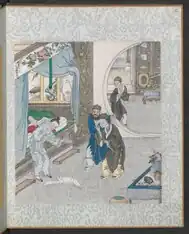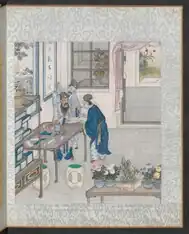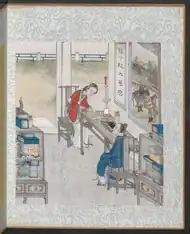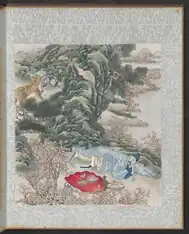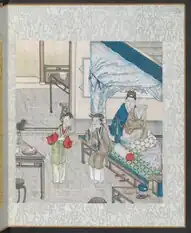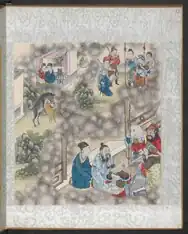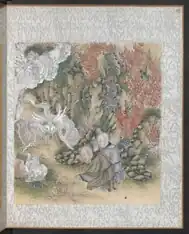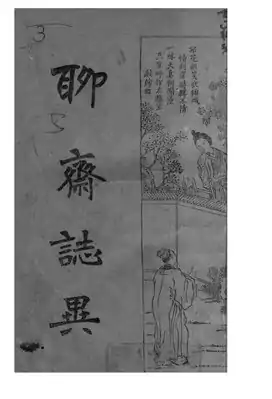 A 1935 edition of Strange Tales from a Chinese Studio | |
| Author | Pu Songling |
|---|---|
| Original title | 聊齋誌異 |
| Country | China |
| Language | Classical Chinese |
| Genre | Zhiguai chuanqi |
Publication date | 1766 |
| Liaozhai zhiyi | |||||||||
|---|---|---|---|---|---|---|---|---|---|
| Traditional Chinese | 聊齋誌異 | ||||||||
| Simplified Chinese | 聊斋志异 | ||||||||
| |||||||||
Liaozhai zhiyi, sometimes shortened to Liaozhai, known in English as Strange Tales from a Chinese Studio, Strange Stories from a Chinese Studio, Strange Tales from Make-Do Studio, or literally Strange Tales from a Studio of Leisure, is a collection of Classical Chinese stories by Qing dynasty writer Pu Songling, comprising close to 500 stories or "marvel tales"[1] in the zhiguai and chuanqi styles, which according to some critics, served to implicitly criticise societal problems. Written over a period of forty years from the late 1600s and ending in the early 1700s, it circulated in manuscripts that were copied and recopied among the author's friends but did not appear in print until 1766. Since then, many of the critically lauded stories have been adapted for other media such as film and television.
Publication history
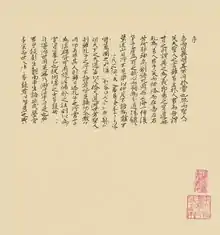
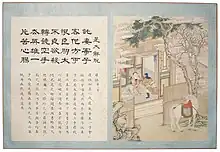
Pu assembled the nearly five hundred anecdotes and lengthy tales over a period of forty years between the early 1670s and the early 1700s.[2] As was the convention of his time, Pu titled his work using the sobriquet Liaozhai (聊齋), translated into English as the "Studio of Conversation" or "Studio of Leisure".[3]
The scholar Zhang Peiheng (章培恒) writes that the original Liaozhai comprised eight volumes, the earliest completed around 1681 and the latest completed between 1707 and 1714.[4] The compilation was first circulated in scribal copies but it was not published until after the author's death in 1715. Around 1693, Shandong financial commissioner Yu Chenglong reportedly offered Pu a thousand taels in exchange for his Liaozhai manuscript, but Pu declined his offer.[5]
The final manuscript was "carefully preserved" by the Pu family after his death, with many different individuals, including the local magistrate, requesting to make copies of it. The earliest surviving print version of Liaozhai was printed in 1766 in Hangzhou by publisher Zhao Qigao (趙起杲),[6] who claimed that Pu originally intended for his anthology to be titled Tales of Ghosts and Foxes (鬼狐傳).[7] Although Zhao also alleged that his publication was based on the "original manuscript" as was copied by a friend,[8] it did not contain all the stories found in the original manuscript;[5] in the preface to his publication, he writes, "I have expunged simple and brief notes which are dull and commonplace, forty-eight in all."[9] Moreover, Zhao censored stories that had "brief references to sensitive topics".[9] Nonetheless, the Zhao edition was well-received and was first republished by scholar Li Shixian (李時憲) in 1767.[10]
At some point after 1871, Pu Jieren (普价人), a seventh-generation descendant of Pu Songling, had the original manuscript, which was reportedly made up of twenty volumes, rebound in eight volumes. They were then kept in two boxes, one of which disappeared "under circumstances which are still obscure".[11] In 1950, the Pu family donated the surviving four volumes, which contained some 237 short stories, to the Liaoning Provincial Library.[11]
Themes
Unlike much Chinese and Western horror fiction, the "scary stories" in Liaozhai are not intended to be frightening, but to blur the borders between the supernatural and everyday reality, using physical and psychological detail to make the move between these realms seem natural.[12] These tales, which are "works rich in romanticism", explore the philosophical concept of qing (情), the passionate and emotional entanglement of the world, be it human or supernatural.[13]
Literary significance
Liaozhai zhiyi is the most acclaimed Chinese "supernatural tales" collection since the three major Ming dynasty hua (話) collections, which are the Jiandeng Xinhua (剪燈新話) by Qu You, the Jiandeng Yuhua (剪燈餘話) by Li Changqi, and the Mideng Yinhua (覓燈因話) by Shao Jingzhan; these three had a far-reaching impact across East Asia.[14]
Early commentary on Liaozhai regarded it as a "superior but typical example" of the zhiguai genre.[15] Subsequent critics and writers disagreed with such a view, instead focusing on the allegorical nature of the stories instead;[16] for instance, Yu Ji, who was Zhao Qigao's secretary, wrote in his preface to Zhao's edition of Liaozhai: "... saying that it differs little from collections of rare phenomena or strange tales is a very shallow view and one that greatly contradicts the author's intent."[17] Pu's grandson, Pu Lide (蒲立德), viewed the work as "an act of serious self-expression".[18]
Still later critics in the nineteenth-century focused on the "literary style and narrative technique" of Liaozhai. Qing dynasty critic Dan Minglun (但明倫) writes in the preface to his 1842 interlinear commentary of Liaozhai: "From Liaozhai, I also gained insight into literary methods."[19] Around the same period, Liaozhai also attracted critical attention from Western writers, for example, Samuel Wells Williams mentioned Liaozhai in his writings as "a perfect work with pure language and elegant style" and its "beautiful writing style" has also received praises from the likes of William Frederick Mayers and Karl Gützlaff.[20]
Since the 20th-century, its literary status was further elevated. Guo Moruo said of Liaozhai that "The writing of ghosts and demons is superior to all others; the satire on corruption and tyranny is penetrating to the marrow."[21] Yuken Fujita of Keio University wrote in 1954 that "Among the many literary works that are descended from ancient Chinese fiction [i.e. Bowuzhi, Soushen Ji, Shishuo Xinyu, Lieyi Zhuan, Shi Yi Ji, etc.], it [Liaozhai] has already established a reputation as the most outstanding short story collection."[22] Hiromasa Imai describes Liaozhai as "the pinnacle of ghost literature."[23] Strange Tales from a Chinese Studio was also listed by Jorge Luis Borges as one of his favorite books.[24]
Influence
Following Liaozhai zhiyi's critical and commercial success, other well-received "wonder tale" and "fantasy" story collections also soon appeared, creating a publishing craze for such literature in China well into the 19th-century. Some notable major collections include Yuan Mei's Zibuyu (What the Master Would Not Discuss, 1788), Shen Qifeng's Xie Duo (1791), Ji Yun's Yuewei caotang biji (Notes of the Thatched Abode of Close Observations, 1789-1798 & 1800) and Wang Tao's Songyin manlu (1875).
Select translations
English
- Strange Tales from Liaozhai, 6 volumes (tr. Sidney L. Sondergard). Jain Pub Co., 2008-2014. ISBN 978-0-89581-001-4.
- Strange Tales from a Chinese Studio (tr. John Minford). London: Penguin, 2006. 562 pages. ISBN 0-14-044740-7.
- Strange Tales from the Liaozhai Studio (Zhang Qingnian, Zhang Ciyun and Yang Yi). Beijing: People's China Publishing, 1997. ISBN 7-80065-599-7.
- Strange Tales from Make-do Studio (Denis C. & Victor H. Mair). Beijing: Foreign Languages Press, 1989. ISBN 7-119-00977-X.
- Strange Tales of Liaozhai (Lu Yunzhong, Chen Tifang, Yang Liyi, and Yang Zhihong). Hong Kong: Commercial Press, 1982.
- Strange Stories from the Lodge of Leisure (George Soulie). London: Constable, 1913.
- Strange Stories from a Chinese Studio (tr. Herbert A. Giles). London: T. De La Rue, 1880; 2nd ed. revised, London, 1908; 3rd ed. revised, London, Laurie, 1916. Reprinted with a new foreword by Victoria Cass. Tokyo, Rutland, Vt.: Tuttle, 2010. ISBN 978-0-8048-9408-1.
Giles's translation
John Minford and Tong Man describe Herbert Giles's translation as "prudish",[25] because he chose not to translate "anything connected with sex, procreation, blood, sometimes indeed the human body in any of its aspects" and often made "extraordinary lengths to cover up his traces, showing considerable craft and cunning."[26] In the Giles translation fox spirits wish to chat and share tea with people rather than trying to seduce and engage in sexual intercourse, and romantic partners at most exchange kisses. They wrote that "Giles was a creature of his time" since he was required to follow Victorian Era morality, and urged readers to "not get Giles' bowdlerising of Liao-chai out of proportion."[26] They added that "the widely distributed Commercial Press (HK) edition of the stories makes many of the same prudish cuts as Giles."[27]
Minford and Tong Man write that people have continued reading Giles's translations even though they "have been at best quietly tolerated, more often derided, and dismissed as orientalist bowdlerisations..."[25] Lydia Chiang describes Minford and Tong Man's essay as a "post-Saidian re-evaluation" that compares the Giles translation to traditional and modern Chinese representations of the story.[28]
German
Martin Buber made the first German translation of the work, included within his Chinesische Geister- und Liebesgeschichten.[29] Buber had assistance from a person named Wang Jingdao. Buber stated in the preface of his translation that his translation had portions previously untranslated in Giles work because Giles, according to the "English custom", had "omitted or paraphrased all passages which seemed to him indecorous".[28] The Chinesische Geister- und Liebesgeschichten was translated into English by Alex Page, published in 1991 by the Humanities Press.[29]
Other translations
Vasily Mikhaylovich Alekseyev published an acclaimed translation of Pu Songling's stories in Russian in two volumes, Fox's Wiles (1922) and The Wizard Monks (1923). It has been cited as the most accomplished translation of the book into a foreign language.[30] The book was translated into Manchu as Sonjofi ubaliyambuha Liyoo jai jy i bithe.[31] Lodovico Nicola di Giura (1868–1947) produced a complete Italian translation of the 1766 edition.[32]
Illustrated editions
In the 19th-century, colorful and fully illustrated collector's editions of Liaozhai zhiyi also circulated onto the literary scenes. These exquisitely mounted illustrated Liaozhai are now collected by major libraries and museums around the world, such as the National Library of China and Library of Congress.
Adaptations

.jpg.webp)
- Liaozhai Zhiyi has inspired many Chinese film adaptations, including those by King Hu (Painted Skin, A Touch of Zen), Gordon Chan (Painted Skin, Mural), Ching Siu-tung (A Chinese Ghost Story series) and the Taiwanese director Li Han-Hsiang (The Enchanting Shadow).[33]
- Jonathan D. Spence. The Death of Woman Wang. (New York: Viking Press, 1978). ISBN 0670262323. Uses material from Liaozhai Zhiyi to set the background.
References
Citations
- ↑ "Pu Songling". Merriam-Webster's Encyclopedia of Literature. Springfield, MA: Merriam-Webster. 1995. ISBN 0-87779-042-6.
- ↑ Barr 2001, pp. 692–693.
- ↑ Zeitlin 1993, p. 1.
- ↑ Barr 1984, p. 516.
- 1 2 Barr 1984, p. 518.
- ↑ Barr 1984, p. 517.
- ↑ Barr 1984, p. 540.
- ↑ Barr 1984, p. 530.
- 1 2 Barr 1984, p. 533.
- ↑ Barr 1984, p. 534.
- 1 2 Barr 1984, p. 519.
- ↑ Barr (2001), p. 692.
- ↑ "The Strange Tales from Liaozhai". 4 Corners of the World: International Collections and Studies...
- ↑ "Ghoulish images from East Asia". bl.uk.
- ↑ Zeitlin 1993, p. 25.
- ↑ Zeitlin 1993, p. 31.
- ↑ Zeitlin 1993, p. 26.
- ↑ Zeitlin 1993, p. 27.
- ↑ Zeitlin 1993, p. 35.
- ↑ "'Liaozhai' in the English-speaking world". Csstoday.com.
- ↑ Sun, Jiahui. "Strange (and Sad) Tales from a Chinese Studio".
- ↑ 藤田祐賢「聊齋志異研究序説 : 特に蒲松齡の執筆態度に就いて」『藝文研究』第3巻、慶應義塾大学文学部藝文学会、1954年1月、 49-61頁、 ISSN 0435-1630、 CRID 1050282813926397312 (in Japanese)。
- ↑ 今井弘昌 「『聊斎志異』の冥界」 『岐阜女子大学紀要』第39号、岐阜女子大学、2010年、 107-116頁、 ISSN 0286-8644、 CRID 1520572358101498496 (in Japanese)。
- ↑ "Jorge Luis Borges Picks 33 of His Favorite Books to Start His Famous Library of Babel". Openculture.com.
- 1 2 Minford and Tong Man, p. 1.
- 1 2 Minford and Tong Man, p. 11.
- ↑ MinfordTong (1999), p. 34.
- 1 2 Chiang, Lydia, p. 72.
- 1 2 Chiang, Lydia, p. 62.
- ↑ Этнокультурное взаимодействие в Евразии. Том 2. Москва: Наука, 2006. ISBN 9785020343726. C. 159.
- ↑ Crossley, Pamela Kyle; Rawski, Evelyn S. (June 1993). "A Profile of The Manchu Language in Ch'ing History". Harvard Journal of Asiatic Studies. Harvard-Yenching Institute. 53 (1): 94. doi:10.2307/2719468. JSTOR 2719468.
- ↑ Lévy, André (2003). "The Liaozhai zhiyi and Honglou meng in French Translation". In Chan, Tak-hung Leo (ed.). One Into Many: Translation and the Dissemination of Classical Chinese Literature. Amsterdam: Rodopi. p. 83. ISBN 90-420-0815-6.
- ↑ Nepstad, Peter (1 September 2000). "Ghost Lovers and Fox Spirits". The Illuminated Lantern.
Bibliography
- Barr, Allan (December 1984). "The Textual Transmission of Liaozhai zhiyi". Harvard Journal of Asiatic Studies. 44 (2): 515–562. doi:10.2307/2719041. JSTOR 2719041.
- Barr, Allan (2001), "37. The Later Classical Tale", in Mair, Victor (ed.), Columbia History of Chinese Literature, NY: Columbia University Press, pp. 675–696, ISBN 978-0-231-10984-0
- Chiang, Lydia Sing-Chen (2005). Collecting The Self: Body And Identity In Strange Tale Collections Of Late Imperial China (Sinica Leidensia Volume 67). Brill. ISBN 9004142037, 9789004142039.
- Minford, John; Tong, Man (1999), "Whose Strange Stories? P'u Sung-ling (1640-1715), Herbert Giles (1845-1935), and the Liao-chai chih-i" (PDF), East Asian History, 17/18
- Chang, Chun-shu and Shelley Hsueh-lun Chang (1998) Redefining History: Ghosts, Spirits, and Human Society in P'u Sung-ling's World, 1640-1715. Ann Arbor: University of Michigan Press. ISBN 0-472-10822-0
- Luo, Hui (University of Toronto Department of East Asian Studies). "The Ghost Of liaozhai: Pu Songling’S Ghostlore And Its History Of Reception." (PhD thesis) (Archive) 2009.
- Wu, Yenna (2019). Ming-Qing Fiction. Oxford University Press.. A selective and annotated bibliography, with a section on Liaozhai
- Zeitlin, Judith T. (1993). Historian of the Strange Pu Songling and the Chinese Classical Tale. Stanford, Calif.: Stanford University Press. ISBN 0804720851..
External links
- Selection of stories as translated by Herbert Giles, 1916 from Google Books
- Strange Stories from a Chinese Studio, 1880, translated and annotated by Herbert A. Giles at Internet Archive
- Hebert Giles (translator) (1880). Strange Stories from a Chinese Studio (Volumes 1 and 2) at Project Gutenberg
- George Soulié (translator) (1913). Strange Stories from the Lodge of Leisures at Project Gutenberg
 Strange Stories from a Chinese Studio public domain audiobook at LibriVox (Giles translation)
Strange Stories from a Chinese Studio public domain audiobook at LibriVox (Giles translation)

